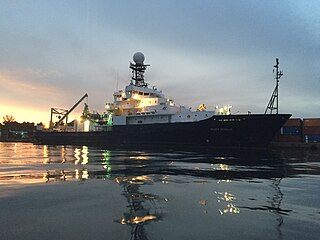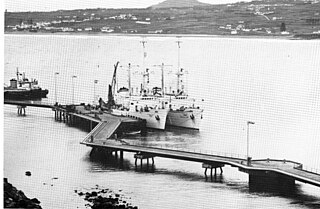
R/P FLIP is an open ocean research platform owned by the U.S. Office of Naval Research (ONR) and operated by Scripps Institution of Oceanography. The platform is 108 meters (355 ft) long and is designed to partially flood and pitch backward 90°, resulting in only the front 17 meters (55 ft) of the platform pointing up out of the water, with bulkheads becoming decks. When flipped, most of the ballast for the platform is provided by water at depths below the influence of surface waves, hence FLIP is stable and mostly immune to wave action similar to a spar buoy. At the end of a mission, compressed air is pumped into the ballast tanks in the flooded section and the platform, which has no propulsion, returns to its horizontal position so it can be towed to a new location. The platform is frequently mistaken for a capsized ocean transport ship.

RV Atlantis is a Thomas G. Thompson-class oceanographic research ship, owned by the US Navy and operated by the Woods Hole Oceanographic Institution as part of the University-National Oceanographic Laboratory System (UNOLS) fleet. She is the host vessel of DSV Alvin. She is named for the first research vessel operated by WHOI, the sailboat RV Atlantis, for which the Space ShuttleAtlantis is also named.

RV Knorr was a research vessel formerly owned by the U.S. Navy and operated by the Woods Hole Oceanographic Institution for the U.S. research community in coordination with and as a part of the University-National Oceanographic Laboratory System (UNOLS) fleet. On March 14, 2016, Knorr was officially transferred to the Mexican Navy and renamed Rio Tecolutla. She was replaced at Woods Hole by the RV Neil Armstrong. Knorr is best known as the ship that supported researchers as they discovered the wreck of the RMS Titanic in 1985. R/V Knorr (AGOR-15) has traveled more than a million miles—the rough equivalent of two round trips to the Moon or forty trips around the Earth. Her sister ship is the RV Melville.

R/V Roger Revelle is a Thomas G. Thompson-class oceanographic research ship operated by Scripps Institution of Oceanography under charter agreement with Office of Naval Research as part of the University-National Oceanographic Laboratory System (UNOLS) fleet. The ship is named after Roger Randall Dougan Revelle, who was essential to the incorporation of Scripps into the University of California San Diego.

R/V Thomas G. Thompson (AGOR-23), an oceanographic research vessel and lead ship of her class, is owned by the United States Office of Naval Research and operated under a bareboat charterparty agreement by the University of Washington as part of the University-National Oceanographic Laboratory System (UNOLS) fleet.

USNS Titan (T-AGOS-15) was a Stalwart-class modified tactical auxiliary general ocean surveillance ship in service in the United States Navy from 1989 to 1993. From 1996 to 2014, she was in commission in the National Oceanic and Atmospheric Administration (NOAA) fleet as the oceanographic research ship NOAAS Ka'imimoana.

USS Chain (ARS-20/T-AGOR-17) was a Diver-class rescue and salvage ship commissioned by the U.S. Navy during World War II. Her task was to come to the aid of stricken vessels.

USS Snatch (ARS-27), well known as Scripps RV Argo after conversion to scientific research, was a Diver-class rescue and salvage ship commissioned by the U.S. Navy during World War II and in service from 11 December 1944 through 23 December 1946. Her task was to come to the aid of stricken vessels. The ship is better known from her scientific research role as the Scripps Institution of Oceanography (SIO) research vessel RV Argo. It is that name, apparently not formally recognized by Navy that maintained title to the vessel, found in the scientific literature and public releases about her wide ranging research voyages.

USS San Carlos (AVP-51) was a Barnegat-class seaplane tender built for the United States Navy during World War II. San Carlos, named after San Carlos Bay, Florida, was in commissioned from 1944 to 1947 and earned three battle stars for service in the Pacific during World War II. After eleven years in reserve, San Carlos was converted to oceanographic research ship USNS Josiah Willard Gibbs (T-AGOR-1)—named after American scientist Josiah Willard Gibbs—and placed in service as a non-commissioned ship of the Military Sea Transportation Service from 1958 to 1971. In December 1971, the ship was transferred to the Hellenic Navy as Hephaistos (A413), a motor torpedo boat tender. Hephaistos was struck from the rolls of the Hellenic Navy in April 1976.

Robert D. Conrad (T-AGOR-3) was a Robert D. Conrad-class oceanographic research ship that operated from 1962 to 1989. The ship, while Navy owned, was operated as the R/V Robert D. Conrad by the Lamont–Doherty Earth Observatory of Columbia University from delivery to inactivation. The ship provided valuable ocean-bottom, particularly seismic profile, information and underwater test data to the U.S. Navy and other U.S. agencies.

USNS James M. Gilliss (T-AGOR-4) was a Robert D. Conrad-class oceanographic research ship acquired by the U.S. Navy in 1962. The ship was operated by the Military Sea Transportation Service and managed by the Naval Oceanographic Office as one of the "Navy Pool" vessels serving various Navy laboratories and projects in the Atlantic Ocean. After active Navy pool service the ship was assigned to the University of Miami to operate as part of the University-National Oceanographic Laboratory System (UNOLS) fleet until 1979.

USNS Sands (T-AGOR-6) was a Robert D. Conrad-class oceanographic research ship operated by the Military Sealift Command (MSC) for the Naval Oceanographic Office from 1965 to 1973. During that period she provided ocean-bottom information and underwater test data to the U.S. Navy and other U.S. agencies. The ship was the second naval vessel to be named for Rear Admiral Benjamin F. Sands and his son Rear Admiral James H. Sands, the first being the destroyer Sands (DD-243). The ship operated in the Atlantic on oceanographic and geophysical assignments for the Oceanographic Office and other agencies.

Thomas G. Thompson (T-AGOR-9) was a Robert D. Conrad-class oceanographic research ship acquired by the U.S. Navy in 1965. The ship was transferred to the University of Washington for operation as part of the University-National Oceanographic Laboratory System (UNOLS) fleet on 21 September 1965. In 1988 the ship went out of UNOLS service. The ship, retaining the previous name, was designated by the Navy as IX-517 assigned to the Mare Island Naval Shipyard for general naval research. Thomas G. Thompson was later renamed Pacific Escort II with the same designation. On 7 May 1997 the Navy renamed the ship Gosport and transferred the ship to the Norfolk Naval Shipyard available for hire as a multi purpose platform from the shipyard. The ship, placed out of service and struck from the register on 27 February 2004, was sunk as part of a NATO exercise 14 November 2004.

Thomas Washington (T-AGOR-10) was a Robert D. Conrad-class oceanographic research ship delivered to the U.S. Navy in 1965. The ship was owned by the Navy but assigned to the Scripps Institute of Oceanography, University of California, La Jolla, California and operated as R/VThomas Washington from delivery to inactivation.

USNS De Steiguer (T-AGOR-12) was a Robert D. Conrad-class oceanographic research ship acquired by the U.S. Navy in 1966. She was a Navy pool vessel assigned to Naval laboratories until she was transferred to the Tunisian Navy in 1992.

USNS Bartlett (T-AGOR-13) was a Robert D. Conrad-class oceanographic research ship acquired by the U.S. Navy (USN) in 1969. She was named after oceanographer Captain John R. Bartlett of the USN. Bartlett was one of the ships under the technical direction of the Naval Oceanographic Office (NAVOCEANO) operating as an Auxiliary General Oceanographic Research (AGOR) program "pool" ship for support of Navy laboratories on each coast as well as NAVOCEANO projects. The ship was first assigned to support laboratories on the West Coast with last operations in similar support on the East Coast and Atlantic.
Gyre (T-AGOR-21), best known as RV Gyre, was the lead ship of her class of oceanographic research ships acquired by the U.S. Navy in 1973 for assignment to the University-National Oceanographic Laboratory System (UNOLS) fleet of Navy owned ships. Gyre was operated by the Texas A&M University School of Oceanography as part of the Navy owned UNOLS fleet until stricken 17 August 1992 and transferred to the university under a program transferring ships to states, schools and other public institutions. The university operated the ship until sale in December 2005.

RV Kilo Moana (AGOR-26) is a small waterplane area twin hull (SWATH) oceanographic research ship owned by the US Navy and operated by the University of Hawaii as a part of the University-National Oceanographic Laboratory System (UNOLS) fleet. She was designed to operate in coastal and blue water areas. The unique SWATH hull-form provides a comfortable, stable platform in high sea conditions.
The University-National Oceanographic Laboratory System (UNOLS) is a group of academic institutions and National Laboratories organized in the United States to coordinate research vessel use for federally funded ocean research.

RV Neil Armstrong (AGOR-27) is the designation for a new oceanographic research ship, first of the Neil Armstrong-class research vessels, to be owned by the United States Navy and operated by Woods Hole Oceanographic Institution. Secretary of the Navy Ray Mabus announced on September 24, 2012, that the research vessel was to be named after Neil Armstrong, the first person to walk on the Moon and a former naval aviator who served in the Korean War.



















